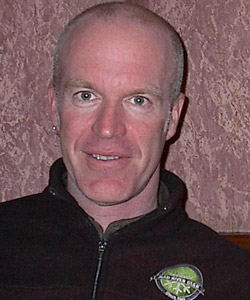By Sarah Russo

Sarah Russo is a writer, cannabis consultant, and a social media and content manager. She got her degree in environmental studies and social justice, with a focus in plant medicine from the Evergreen State College. She has previously worked for Project CBD and the Society of Cannabis Clinicians. She has also acted as an herbal medicine educator in natural remedy apothecary shops. Some of her main goals are diversifying the cannabis movement by integrating the plant into the greater herbal medicine compendium as well as encouraging sustainable agricultural practices.
Meet the Experts is a series of interviews conducted by experts from the field of Cannabis to world leaders in research and clinical practice of Cannabis as medicine.

Dr. McPartland first studied medicinal plants with Euell Gibbons in 1969, and began cannabinoid research in 1981 (Mycopathologia 87:149-153).
His formal training accrued at Penn State (BS, Botany and Chemistry), University of Illinois (MS, Plant Pathology), Chicago College of Osteopathy (DO, Doctor of Osteopathy), University of Pittsburgh (Family Medicine Residency), and Michigan State University (Fellowship in Biomechanics).
He has composed and delivered osteopathic medical curriculum (including pharmacology) at Michigan State University (Assistant Professor) and Unitec New Zealand (Associate Professor).
Sarah Russo: What has changed the most in the scientific landscape since you first began researching cannabis and the endocannabinoid system (ECS)?
John McPartland: When I got started in this business, there were no cannabinoid receptors, no endogenous ligands. Allyn Howlett and Bill Devane discovered CB1 in 1988, at Washington University. Then Devane moved to Jerusalem and teamed with Lumír Hanuš and Raphi Mechoulam, and discovered anandamide (AEA) in 1992.
SR: What is the biggest point of misinformation going around about cannabis from an educational perspective?
JMcP: Wishful-thinking Americans say CBD is legal, but it is not. In 2016 the DEA reaffirmed that CBD extracts are federally prohibited, under their drug code number 7350. The Federal government can bust you, if they choose to selectively exercise their prerogative.
SR: The topic of indica and sativa are often thrown around to describe effect of different types of cannabis. Does the taxonomy of the cannabis plant have anything to do with user experience?
JMcP: User experience employs a vernacular taxonomy of "Sativa" (plants that generate a stimulating and energizing experience, with a sweet terpenoid profile), and "Indica" (relaxing and sedating, with a skunky aroma). This distinction is becoming muddled because new Sativa-Indica hybrids are randomly assigned to one or the other category.
Furthermore, this nomenclature does not align with formal botanical taxonomy. Formally, Cannabis sativa subspecies sativa is European hemp—traditionally used for rope, not dope. The subspecies sold in dispensaries is C. sativa subsp. indica. It consists of two varieties: C. sativa subsp. indica var. indica (a.k.a. "Sativa"), and C. sativa subsp. indica var. afghanica (a.k.a. "Indica").
SR: How can cannabis be used as a companion plant and benefit a garden with other botanicals?
JMcP: I'm less enthusiastic about cannabis as a companion plant, than when we wrote Hemp Diseases and Pests in 2000. For sure, densely-sown hemp plants will squelch weed growth. A Cannabis crop will suppress nematode (certain types of worm) populations in the soil for sequential crops. There's literature saying Cannabis will repel caterpillars and beetles from neighboring plants. Rather than a companion plant, more research documents success with cannabis extracts: soaking fresh or dried leaves or flowers in water or ethanol, filtering, and spraying the extract on other crop plants.
SR: Can you discuss the evolutionary mutualism between humans and cannabis? Is there a distinction between the cannabis plant's natural selection and how humans have influenced and altered its evolution?
JMcP: Cannabis, like many crop plants, has undergone two rounds of evolution: first, around 28 million years of natural selection to survive environmental pressures—including avian and mammalian herbivores. Second, recent accelerated evolution by humans who have selected plants for optimal benefit and minimal toxicity. Coevolution refers to reciprocal genetic adaptations between two species in response to each other. Cannabis research shows that the genes for THCA-synthase and CBDA-synthase (CBDA-S) have undergone "purifying selection," a process driven through human selection. THC-rich hybrids have non-functional copies of CBDA-S, and CBD-rich hybrids encode THCA-S pseudogenes.
Reciprocally, human exposure to THC for thousands of years has caused positive selection in genes that express the ECS. In 2007 we found evidence of positive selection in the gene encoding DAGL—the biosynthetic enzyme of 2-AG. This was seen in Asian populations, who have been exposed to Cannabis longer than Europeans and Africans. Ruth Ross's group in 2012 identified a polymorphic locus in the gene for CB1, which they thought represented a co-evolutionary adaptation in populations exposed to Cannabis for thousands of years.
SR: Can you explain a bit about the fossilized cannabis pollen samples you've researched?
JMcP: Thanks to scientific interest in climate change, a growing number of fossil pollen studies (FPSs) have attested to changes in vegetation over long periods of time. Cannabis pollen appears sporadically in these studies, but when hundreds of studies are combined, some signals emerge. We analyzed 603 European FPSs, and concluded that Cannabis grew indigenously in Europe during the last Ice Age, when the landscape was dominated by steppe and dry tundra. As the Ice Age retreated and trees filled the landscape, Cannabis pollen disappeared. Then surges of pollen arise, suggestive of hemp cultivation, during the Bronze Age and Iron Age. The oldest Cannabis pollen in Europe appeared during a previous Ice Age, known as the Olduvai cold stage, about 1.8 million years ago. That's young compared to Asia, where Cannabis pollen dates back to 19.6 million years ago. The European population may be the ancestor of C. sativa subsp. sativa, and the Asian population may be the ancestor of C. sativa subsp. indica.
SR: The runner's high phenomena used to be attributed solely to endorphin release, but you have investigated the ECS connection. Can you give some specifics about this?
JMcP: Years ago I noticed that running a hard 10k elicited a pleasant "purple haze" (now a name given to a popular strain). The cannabimimetic sensation was particularly evident during periods when I wasn't partaking—when my CB1 receptors were up-regulated. A related sensation occurred after receiving osteopathic or chiropractic manipulation. So in 2005 we measured anandamide (AEA) levels in 31 subjects, before and after manipulation, compared to a placebo control (we devised a believable sham manipulation using a "calculated deception" protocol). Post-treatment AEA levels increased 168% over pre-treatment levels, compared to no change in placebo subjects. Since then, several groups have linked runner's high with AEA levels, in animal models and in humans. In the animals, runner's high was detected as anxiolysis and analgesia. The ECS can be upregulated many ways, read Care and Feeding of the Endocannabinoid System for more details.
SR: Can you describe the scientific evidence that supports the synergistic action of cannabis compounds?
JMcP: Historically there's been four rounds of synergy research. In the 1890s, David Prain concluded, "The volatile oil [terpenoids] and the resin [cannabinoids] are both active; that is, the "active principle" of gánjá is not a simple substance, but consists of at least two distinct things." Walter Loewe, who invented a way to measure supra-additive synergism (isobologram analysis), studied cannabis between 1938 and 1950. His work was amazing—last month I went through his archived papers, housed at the University of Utah, and I'm writing a review.
Next came the 1970s. Ten years after Mechoulam successfully described THC, a flurry of studies showed that cannabis extracts—containing multiple ingredients—produced greater effects than expected from their THC content alone. Between 1970 and 1995, 18 animal studies and 7 human studies documented interactions between CBD and THC. Our current round of research began in 1998, which marks the founding of GW Pharmaceuticals, committed to the concept of synergy in whole plant extracts. And, may I add, McPartland and Pruitt (1998) published a seminal review of therapeutic synergy in cannabis. For an update on the scientific evidence, check out Taming THC by Ethan Russo.
SR: You've examined the issue of cannabis pesticides and contaminants long before cannabis testing was readily available. How has this issue evolved from when you first began studying this topic to now? What are the biggest issues with quality control from your perspective?
JMcP: The use of pesticides is a rising crisis, and a breakdown in ethics. Holmes's group estimated that pesticide residues were found on close to half of the cannabis sold in Oregon dispensaries in 2015. Evidence of pesticide usage by sloppy and unscrupulous growers goes back to the 1970s. It's gotten way worse, thanks to Big Money underwriting mega-grows. Faced with a pest or a pathogen taking down a mega-grow, the temptation to spray poisons becomes overwhelming. It's why we need legalization and regulation with pesticide residue testing. And legalization must contain provisions for self-cultivation, because people rarely poison their own weed.
SR: Thank you for your time and insight, John.


